
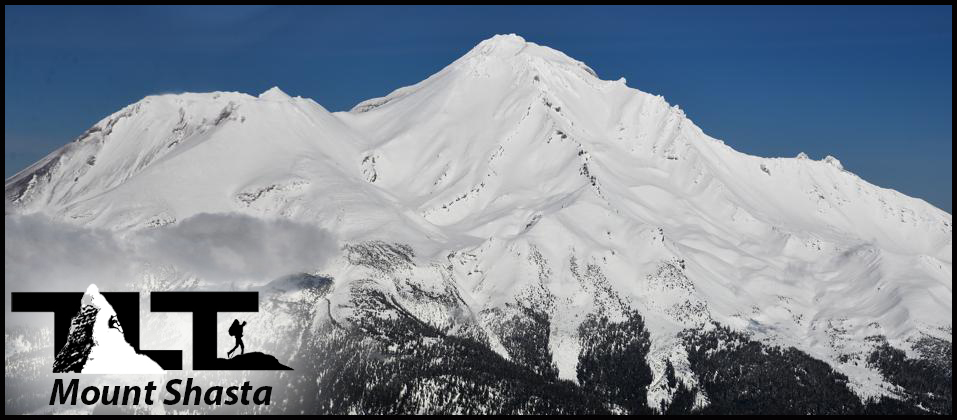 Mt Shasta is known to many as the Mt Everest of California. It dominates the skyline in the Northern California region, rising 10,000 vertical feet above its base to a height of 14,179 feet. It can be seen from over a hundred miles away.
Mt Shasta is known to many as the Mt Everest of California. It dominates the skyline in the Northern California region, rising 10,000 vertical feet above its base to a height of 14,179 feet. It can be seen from over a hundred miles away.Shasta is the second highest of all the Cascade volcanoes, just behind Mt Rainier. Even though many people come to Mt Shasta for skiing and other outdoor activities, mountain climbing is recognized as the main recreational attraction of Shasta. Over 15,000 people each year put their skills to the test in an attempt to reach its lofty 14,179 foot summit, but only a third of this number actually reach their goal according to statistics. Mount Shasta also holds the honor of being one of California's 15 fourteen thousand footers. So it holds an interest to those working to complete the goal of climbing all 15 of those peaks as well. Shasta hosts seven named glaciers including the Whitney Glacier, which is a two mile long river of ice and is the largest glacier in the US state of California.
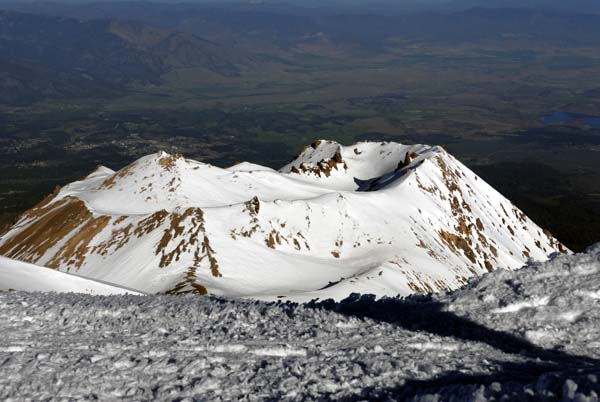 Climbing Mt Shasta is a memorable and challenging experience. During the mid-19th Century the climbing excitement was magnified by the fact that it took a considerable amount of effort just to reach the mountain.
Climbing Mt Shasta is a memorable and challenging experience. During the mid-19th Century the climbing excitement was magnified by the fact that it took a considerable amount of effort just to reach the mountain.The first recorded ascent of Mount Shasta was by Captain E.D. Pearce, a Yreka sawmill foreman, in 1854. Then a few years later, Clarence King climbed the peak. There were five in his party and they ascended the Shastina peak, (photo to the right) camping overnight on the rim of the crater. The next morning, after a light breakfast, they hiked the connecting saddle to Mt. Shasta's peak. King wrote in his journal: "A singularly transparent air revealed every plain and peak until the earth's curve rolled them under remote horizons. The whole great disk of world beneath wore an aspect of glorious cheerfulness. It seemed incredible that we could see so far toward the Columbia River, almost across the state of Oregon - but there stood the Pit, Jefferson and the Three Sisters in unmistakable plainness."
Clarence King was so impressed with Mt. Shasta that he stayed on the summit all day viewing the vast scenes that spread out like a carpet below him. Before leaving the summit the party waved the American flag for a moment and then went down to the hot springs just below the peak and prepared camp for the night. They used lava boulders to shield themselves from the biting cold wind that howled relentlessly all night long. After a glorious sunrise, they shouldered their packs and hurried down the mountain to Sisson's inn for a hot meal and a comfortable bed. In his exploits King is credited with discovering Shasta's glaciers, and the hidden frozen lake inside Shastina crater is named after him.
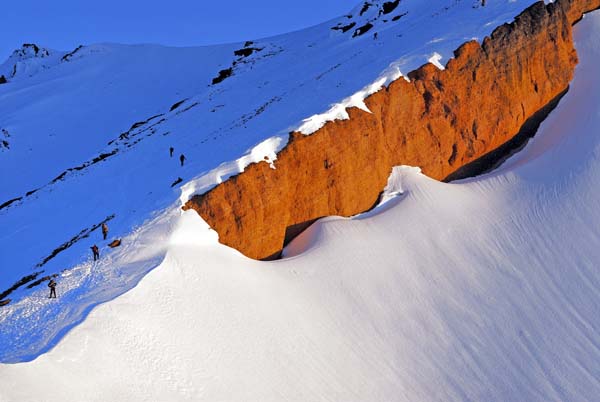 Modern day hikers/climbers do not have it nearly so difficult as the early explorers of centuries gone by. Approaches to many of the routes are made easy by way of paved highways. But the spirit of adventure is still high and most trails eventually peter out, and cross country navigation and travel become a must. But modern day equipment such as crampons and light weight ice axes make travel over snow and ice much more manageable, and I prefer the spring months when the mountain is still clothed with a good coat of snow to the later season when endless slopes of loose scree must be overcome.
Modern day hikers/climbers do not have it nearly so difficult as the early explorers of centuries gone by. Approaches to many of the routes are made easy by way of paved highways. But the spirit of adventure is still high and most trails eventually peter out, and cross country navigation and travel become a must. But modern day equipment such as crampons and light weight ice axes make travel over snow and ice much more manageable, and I prefer the spring months when the mountain is still clothed with a good coat of snow to the later season when endless slopes of loose scree must be overcome.In the photo above you see the beautiful early morning lighting on the red cliffs, as climbers make their way up the steep snow and ice above Red Banks. They are nearly to the base of Misery Hill which is well named, because at this point of the climb it seems that getting to the summit has become just as much of a mental battle as a physical one
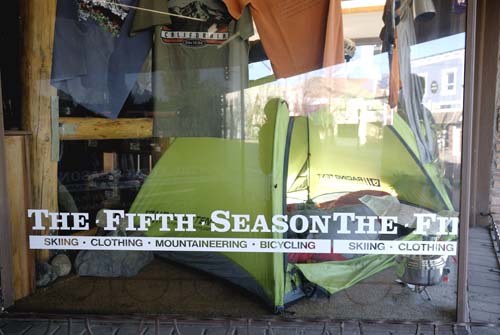 Climbing information and equipment can be obtained from The Fifth Season (image to the left), (image above), a local outfitter, located at 300 North Mt Shasta Blvd., Mount Shasta, CA 96067. Their phone number is 530-926-3606. They also provide rentals. The Fifth Season also has a 24 hour weather and climbing condition hot line at 530-926-5555.
Climbing information and equipment can be obtained from The Fifth Season (image to the left), (image above), a local outfitter, located at 300 North Mt Shasta Blvd., Mount Shasta, CA 96067. Their phone number is 530-926-3606. They also provide rentals. The Fifth Season also has a 24 hour weather and climbing condition hot line at 530-926-5555.Unless you are late in the summer months, or in a very low snowfall year, crampons and ice ax are a must on Mt Shasta. I remember years ago, while climbing on the mountain with my father, watching a guy attempt to proceed up Avalanche Gulch without either. After slipping and falling several times, he gave up and went down. Good thing, for if he had been able to go much higher he possible would have really hurt or even kill himself.
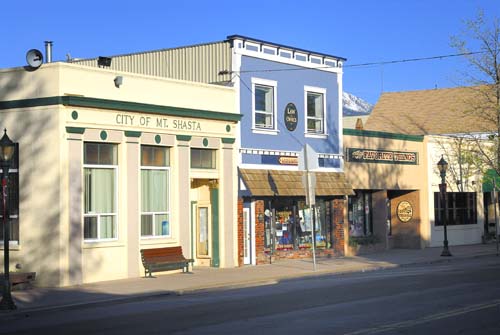
While on your adventure to explore and possibly climb Mt Shasta, don't forget to spend a little time checking out the quaint little town of Mt Shasta City that sits over 10,000 ft below the summit of Mt Shasta (photo to the right). (photo above).
Mount Shasta is a city in Siskiyou County, California located at around 3,600 feet on the lower flanks of Shasta itself. It is a prominent northern California landmark. The city is only 9 miles southwest of the summit of Shasta. As of the 2000 Census the city had a total population of 3,275 with approximately 3,000 additional residents living immediately outside the city limits. Over the last decade, however, the number still calling Mt Shasta home has dwindled a bit.
Coming from a large metropolitan area like Los Angeles, I love to spend a little time in these small towns. It seems to slow life down a bit, and those of us who hurry around most of our lives fighting crowds and congestion can appreciate a place like Mt Shasta City.
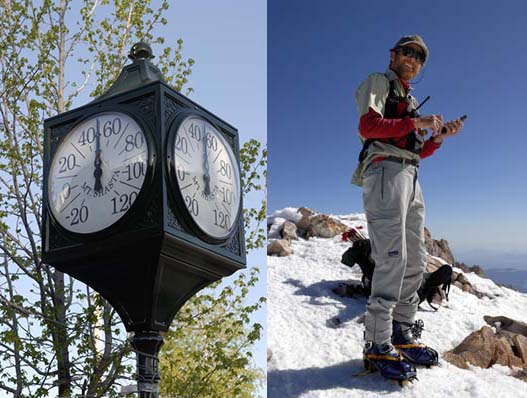 In the photos on the left, above, you see the large temperature gauge located in the heart of Mt Shasta City on one of the main streets, and one of the mountain climbing forest rangers who just happened to hit the summit at about the same time we did. As you can see, the temperature in the city was 50 degrees F, at about 8:30AM, while the very next day on the summit (at about 9AM), the temperature was about 36 degrees.
In the photos on the left, above, you see the large temperature gauge located in the heart of Mt Shasta City on one of the main streets, and one of the mountain climbing forest rangers who just happened to hit the summit at about the same time we did. As you can see, the temperature in the city was 50 degrees F, at about 8:30AM, while the very next day on the summit (at about 9AM), the temperature was about 36 degrees.But weather can change fast in the mountains, and Mt Shasta is known for making its own weather. So you need to be prepared for harsh conditions should things not go your way. We always carry several layers of clothing, including wind and rain protection. Good gloves and a good insulated hat are also necessary. The mountain has no mercy for the unprepared, and cold injuries are common on Mt Shasta.
In the above photo, you see a photo of one of the climbing rangers on the summit. They patrol the mountain and are there to help out when people get in trouble on the mountain, but as with any wilderness outing, you need to be prepared for problems or injuries on you own, because you can't always count on these guys to be around when you need them. Mt Shasta Rangers are also a source for information on current conditions. This can be a great help when the slopes or weather on the mountain is unstable. They usually hang out at Lake Helen (when not patrolling the slopes) where they have a good size tent set up for their headquarters. Also make sure you have your summit pass on you, because the climbing Rangers will often check to make sure that you are carrying one if you go above 10,000 feet. More about this on our Getting Started page.
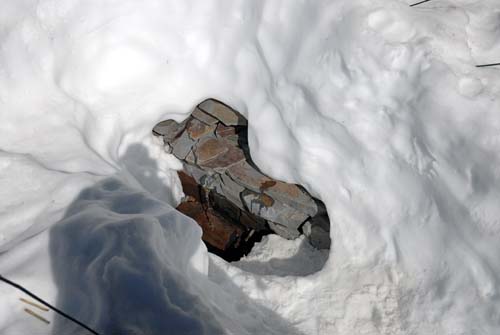 Normally in the summer months you have an above ground running spring coming out of a pipe. Some say it is the cleanest, freshest water in all of California. This little spring is located at Horse Camp, and it is run by the Sierra Club. Our climb on May 17th, 2009 found the little spring buried down about 5 feet under the snow (image to the right). (Image above). The camp caretaker had placed wands around the hole so people would not fall in, and created some snow steps to give access to the water below so you could fill up your water bottles if need be.
Normally in the summer months you have an above ground running spring coming out of a pipe. Some say it is the cleanest, freshest water in all of California. This little spring is located at Horse Camp, and it is run by the Sierra Club. Our climb on May 17th, 2009 found the little spring buried down about 5 feet under the snow (image to the right). (Image above). The camp caretaker had placed wands around the hole so people would not fall in, and created some snow steps to give access to the water below so you could fill up your water bottles if need be.In the late summer months, this little spring is the last source of reliable water before pushing on. But Mt Shasta is never completely void of snow, so carrying a pot, fuel, and stove will enable you to get water further up.
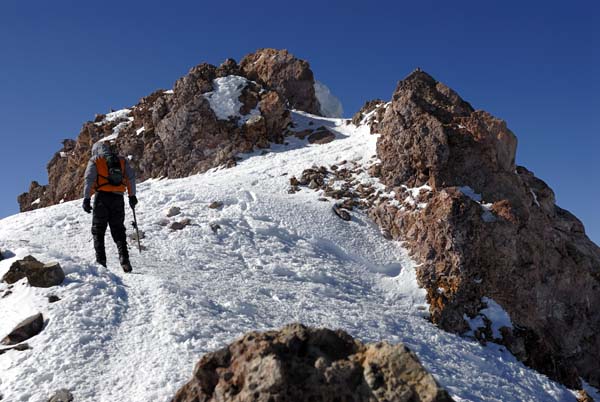 All in all, Mt Shasta has much to offer when it comes to hiking, climbing, skiing, and other outdoor activities. But you need to take the mountain serious and come prepared.
All in all, Mt Shasta has much to offer when it comes to hiking, climbing, skiing, and other outdoor activities. But you need to take the mountain serious and come prepared.On the left, Above, you see my son Ben making his way up the final slopes of Mt Shasta just before gaining the summit. I have to say that it is a great feeling to be on top of this giant volcano, and the views from atop are nothing short of spectacular. Well worth the effort.
So please make use of the above side links at the Top of this Page for more information on Mt Shasta. They contain information on climbing up Shasta's most popular route, Avalanche Gulch.
Email Sign Up
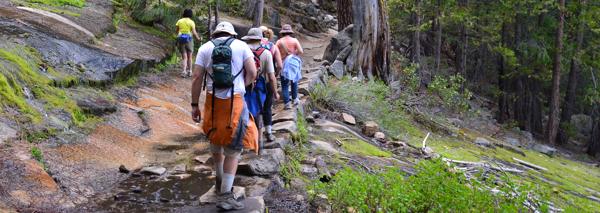
| Join the Adventure! Sign up here for Timberline Trails Monthly Newsletter |

Join us on Instagram

©2006-2024 TimberlineTrails. All Rights Reserved.
....